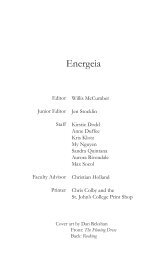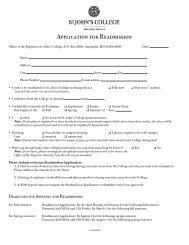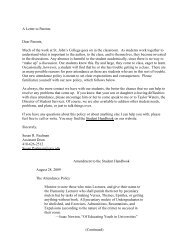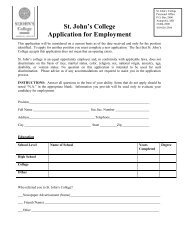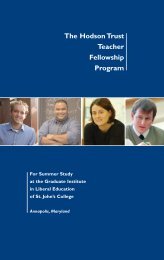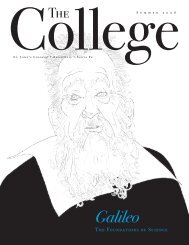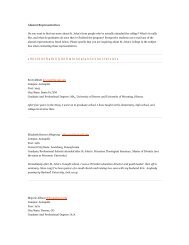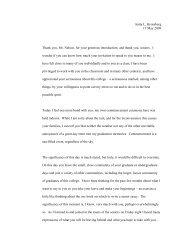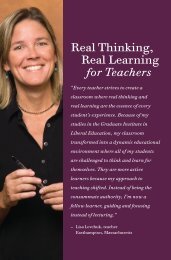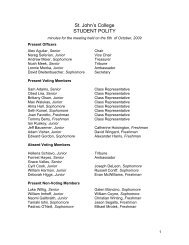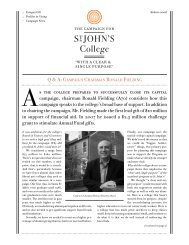âTo Meet with Macbeth,â given by tutor Louis ... - St. John's College
âTo Meet with Macbeth,â given by tutor Louis ... - St. John's College
âTo Meet with Macbeth,â given by tutor Louis ... - St. John's College
You also want an ePaper? Increase the reach of your titles
YUMPU automatically turns print PDFs into web optimized ePapers that Google loves.
that Shakespeare should have played the part. Seyton speaks <strong>with</strong> coolness of nerve to <strong>Macbeth</strong>, while<br />
others shake in his presence. He watches the action, interprets the sounds, and helps his lord timely to<br />
arm. He has but five lines to speak. Each line corresponds in order to each of the five acts of the play.<br />
Seyton’s first line: “What is your gracious pleasure?” (V.iii.30). This is the question of Act I:<br />
what pleasures in life do this warrior and his wife most deeply desire to enact, but graciously so, <strong>by</strong><br />
struggle or beguilement, so as to remain fair and free? Seyton’s second line: “All is confirmed, my lord,<br />
which was reported” (V.iii. 31). This is Act II: <strong>Macbeth</strong> is confirmed as king, as was reported <strong>by</strong> the<br />
Weird Sisters and <strong>by</strong> Lady <strong>Macbeth</strong>, who taught him how to be one in act and desire and to get away<br />
<strong>with</strong> murder. Seyton’s third line, in response to <strong>Macbeth</strong>’s, “Give me my armor”: “’Tis not needed yet.”<br />
“I’ll put in on,” <strong>Macbeth</strong> insists (V.iii.33-34). This is Act III: the murder of Banquo, who represents to<br />
<strong>Macbeth</strong> the “not yet” doubleness of action, that is, action for the sake of the present actor and for<br />
someone not yet present. The armor <strong>Macbeth</strong> puts on in the present to fight the “not yet” makes him<br />
known in Act III as a tyrant. Also in Act III we learn that Macduff flies to England, a double action that<br />
turns out in one sense not to be needed, since the forces of invasion are well provided and ready <strong>by</strong> the<br />
time he arrives there; but in another sense the deadly consequences of his untimely flight make him the<br />
one who can kill the tyrant. Seyton’s fourth line: “It is the cry of women, my good lord” (V.v.8). This is<br />
Act IV: the chanting of the Weird Sisters around the cauldron raised to fever pitch—“Double, double, toil<br />
and trouble;/Fire burn and cauldron bubble” (IV.i.10-11, 20-21, 35-36); the exit of Lady Macduff (and<br />
other wives and mothers), crying “Murder!”; and the news of their slaughter brought to Macduff in<br />
England, his goodness terrible, uncrying, not a woman’s kind of goodness. Seyton’s fifth line: “The<br />
Queen, my lord, is dead” (V.v.16). This is Act V: Lady <strong>Macbeth</strong>, here called “Queen” for the first time,<br />
dies offstage--we do not know how--nor does <strong>Macbeth</strong> have the time or interest to inquire. The<br />
question of Act V is that of time itself: what is its interest and meaning as measured in the sounds and<br />
49




